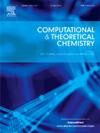DFT approach study of the hydrogenation of Ni- and V- octaethylporphyrins catalyzed by MoS2 promoted with Fe, Co or Ni
IF 3
3区 化学
Q3 CHEMISTRY, PHYSICAL
引用次数: 0
Abstract
The effect of promoting the catalytic surface of MoS2 with Fe, Co and Ni, utilized in the hydrodemetallization reactions of heavy oil fractions, was investigated using the model porphyrins VO-octaethylporphyrinate and Ni-octaethylporphyrinate. Density Functional Theory was employed to simulate a representative chemical environment with two hydrogen molecules. For this purpose, a catalytically active site was defined. The results indicated that porphyrins exhibited the strongest chemisorption in the molybdenum-exposed region, followed by the sulfur-exposed region. Furthermore, the initial hydrogenation was favored on the Co- and Fe-promoted catalytic surfaces with both porphyrins. Similarly, the Co- and Fe-promoted surfaces interacting with Ni-OEP demonstrated strong chemisorption of a second H2 molecule, whereas for VO-OEP, the second H2 molecule exhibited favorable chemisorption with the Fe-promoted catalytic surface. These findings suggest that two H2 molecules are necessary to weaken the macrocyclic bonds of the porphyrins.

求助全文
约1分钟内获得全文
求助全文
来源期刊

Computational and Theoretical Chemistry
CHEMISTRY, PHYSICAL-
CiteScore
4.20
自引率
10.70%
发文量
331
审稿时长
31 days
期刊介绍:
Computational and Theoretical Chemistry publishes high quality, original reports of significance in computational and theoretical chemistry including those that deal with problems of structure, properties, energetics, weak interactions, reaction mechanisms, catalysis, and reaction rates involving atoms, molecules, clusters, surfaces, and bulk matter.
 求助内容:
求助内容: 应助结果提醒方式:
应助结果提醒方式:


